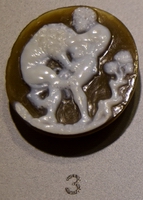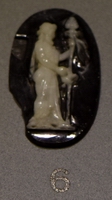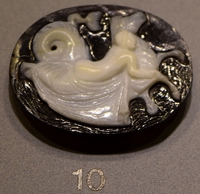Indice dei Musei
presenti in miti3000
Napoli Museo Nazionale - Piano Terra - Collezione Farnese - sala X - Vetrina 1 - Cardinale Pietro Barbo (Paolo II)"
Testo
I GRANDI COLLEZIONISTI: PIETRO BARBO - LORENZO DE’ MEDICI
Il veneziano Pietro Barbo, cardinale di San Marco, che divenne papa nel 1464 col nome di Paolo II, raccoglie a Roma nel Palazzo S. Marco (ora Palazzo Venezia), una ingente collezione di gemme incise, monete, medaglie, bronzi, gioielli, argenterie, arazzi e statue.
Un inventario compilato nel 1457 descrive minuziosamente la collezione di gemme: 243 cammei e 578 intagli, così come erano disposti nelle apposite tavole d’argento dorato che portavano le insegne del cardinale. Questo inventario ha permesso di riconoscere come sicuramente appartenenti all’antica collezione Barbo le gemme qui esposte (vetrina 1); tra queste si segnalano per qualità artistica due cammei con Menadi (7-8) per le quali è stata avanzata una attribuzione all’incisore Sostratos.
Alla morte di Paolo II nel 1471, il suo successore, papa Sisto IV, la cui elezione era stata favorita dai Medici, donò o vendette a un prezzo simbolico, a Lorenzo de’ Medici alcune gemme di altissimo livello artistico, venendo così ad arricchire la collezione medicea iniziata da Cosimo e poi trasferita al figlio Piero. Tra questi si segnala una serie di cammei firmati o attribuibili a maestri della glittica del I secolo a.C.: Protarchos e Sostratos. Un particolare rilievo per la dignità formale e le implicazioni concettuali assumono la corniola con il trionfo di Apollo sul sileno Marsia (46), tradizionalmente identificata col sigillo di Nerone, e il cammeo con la scena della gara tra Atena e Poseidone per il dominio dell’Attica (28), derivata dal frontone fidiaco del Partenone.
Su tutte la sigla incisa LAV.R.MED., che ne testimonia l’appartenenza alla collezione di Lorenzo.
La qualità altissima di molte delle gemme Barbo e Medici lascia supporre che esse possano provenire dalla dispersione del tesoro imperiale di Costantinopoli, in seguito alla presa di Bisanzio nel 1204.
Le gemme di Lorenzo qui esposte entrarono, per via ereditaria, in possesso di Margherita d’Austria, vedova di Alessandro dei Medici e sposa in seconde nozze di Ottavio Farnese nel 1538, e confluirono, alla morte di questa nel 1586, nel patrimonio dei duchi di Parma.
THE GREA T COLLECTORS: PIETRO BARBO - LORENZO DE’ MEDICI
The Venetian Pietro Barbo, cardinal of St. Mark, who became Pope in 1464 under the name of Paolo II, brought together in the Palazzo S. Marco in Rome (today Palazzo Venezia) a remarkable collection of incised gems, coins, medallions, bronzes, Jewels, silverware, tapestry and statues.
An inventory drawn up in 1457 describes in detail his gem collection, 243 cameos and 5780 intaglios, arranged in expressly made gilded silver plates bearing the cardinal’s insignia. This inventory has made it possible to recognize as surely pertaining to the ancient Barbo collection the gems shown in this room (show-case 1). Among these are two cameos representing Maenads (7 and 8), of exceptional artistic quality, attributed to the engraver Sostratos.
After the death of Paolo II in 1471, his successor, Pope Sisto IV, whose election had been favored by the Medici, presented Lorenzo de’ Medici with some gems of very high artistic value (or sold them to him at a symbolic price). These gems thus became part of the Medici collection, started by Cosimo and them passed on to his son Piero. Among them were a series of cameos signed by, or that can be attributed to, the I century BC master engravers Protarchos and Sostratos. Both the cornelian gem with Apollo’s triumph over the Silen Marsyas (46), traditionally identified as Nero’s seal, and the cameo representing the contest between Poseidone and Athena for the dominion of Attica (28), a scene derived from Phidias’ pediment of the Parthenon, are remarkable for their formal dignity and conceptual implications.
All of these gems bear the incised monogram LA V.R.MED., indicating that they belonged to the collection of Lorenzo de’ Medici.
The exceptional quality of some of the Barbo and Medici gems suggests that they could have originally been part of the imperial treasure of Constantinople, dispersed after the seizing of Byzantium in 1204.
Those of Lorenzo’s gems that are on exhibit here were inherited in 1538 by Marguerite of Austria, the widow of Alessandro de’ Medici, later wife of Ottavio Farnese, and were incorporated, after her death in 1586, into the patrimony of the dukes of Parma.
LA COLLEZIONE DI GEMME DI FULVIO ORSINI
Antiquario e bibliotecario dei Farnese, Fulvio Orsini (1529-1600) trascorre la sua esistenza dapprima al seguito del cardinale Ranuccio, poi, alla morte di questi, al servizio del fratello Alessandro (1520-1589) con il compito di curare l’ordinamento e lo sviluppo delle raccolte di antichità, di libri e manoscritti della famiglia. Autore di numerosi studi di carattere filologico, storico e antiquario, formerà una sua propria collezione di quadri, sculture, iscrizioni, monete, gemme.
Un inventario redatto dall’Orsini poco prima della morte, nel quale egli registra tutti i suoi beni artistici con l’indicazione del valore e del precedente proprietario, permette di valutare l’entità - ingente - delle raccolte, destinate a passare nel 1600 in proprietà del cardinale Odoardo, nominato dall’Orsini stesso erede universale dei suoi beni.
Le antichità di Fulvio Orsini si ricongiungono in tal modo alle collezioni antiquarie di Alessandro Farnese, accrescendo così quel complesso di materiali destinato a costituire, nelle intenzioni del cardinale, uno “studio publico” offerto, insieme al patrimonio librario e artistico della famiglia, alla frequentazione di una più ampia cerchia di studiosi.
Le monete, le iscrizioni, i marmi e le gemme di Fulvio Orsini sono oggi solo in parte identificabili nelle raccolte Farnese conservate nel Museo Nazionale di Napoli. Le gemme in particolare, in origine più di 400, dopo il loro trasferimento alla corte di Parma e la fusione col resto del Tesoro Farnese; furono in parte alienate o disperse; alcune sono oggi conservate nei musei di San Pietroburgo, Parigi, Londra, e in altre collezioni europee.
Attualmente solo ottanta di esse, tra gemme e cammei antichi e moderni, sono riconoscibili nella raccolta napoletana. Tra esse emergono alcuni capolavori della glittica di età ellenistica o augustea, talvolta firmati da noti maestri: Athenion, Sostratos, Apollonios, Dioskourides. La qualità sempre elevata delle pietre, la peculiarità dei soggetti e testimonianza eloquente del gusto e della sensibilità scientifica dell’Orsini.
THE GEM COLLECTION OF FULVIO ORSINI
Fulvio Orsini (1592-1600), antiquarian and librarian of the Farnese family, spent his lifetime first in the retinue of cardinal Ranuccio, then, after the latter’s death, in that of his brother Alessandro (1520-1589). He was assigned the task of keeping in order and augmenting the family’s collection of antiquities, books and manuscripts. He is the author of numerous philological, historical and antiquarian studies, and formed his own collection of paintings, sculpture, inscriptions, coins and gems.
An inventory drawn up by Orsini shortly before his death, in which he records all of the works of art in his possession, with the indication of the value and former owner of each, bears witness to the importance of his collection which, in 1600, became the property of cardinal Odoardo, designated by Orsini as heir to all his possessions.
Fulvio Orsini’s antiquities thus joined the antiquarian collections of Alessandro Farnese, a corpus of material meant by the cardinal to serve, along with the library and the artistic patrimony of the family, as a “studio publico”, open to a wide circle of scholars. Only some of the coins, the inscriptions, the marble sculpture and the gems of Fulvio Orsini’s collection can be identified among the Farnese objects in the Naples Archaeological Museum.
The gems, originally more than 400, after being transferred to the court of Parma and incorporated into the rest of the Farnese treasure, were in part given away or dispersed. Some are now in the museums of St. Petersburg, Paris, London and in other European collections. Only eighty of the Orsini gems and ancient and modem cameos are recognizable today in the Neapolitan collection.
Among these are a few master-pieces of Hellenistic and Augustan glyptics, sometimes signed by renowned masters, such as Athenion, Sostratos, Apollonios and Dioskourides. The high quality of the stones and the originality of the subjects depicted bear witness to Orsini’s good taste and scientific awareness.
LE IMAGINES VIRORUM ILLUSTRIUM E LE GEMME ORSINI
Nella collezione di gemme di Fulvio Orsini gli intagli e cammei raffiguranti personaggi celebri del mondo antico costituiscono una presenza numericamente significativa, indizio di un interesse scientifico preciso, che trova riflesso anche nella collezione di monete e in quella di sculture - quasi tutte ritratti - raccolte a Palazzo Farnese dall'Orsini stesso.
Nei decenni centrali del XVI secolo numerose sono le iniziative scientifiche volte ad affrontare la interpretazione e la definizione sistematica del patrimonio figurativo antico, nonché, all'interno di questo, la identificazione degli uomini illustri del passato - politici, filosofi, letterati - così come era stato possibile, sulla base delle effigi monetali, per i sovrani ellenistici e gli imperatori romani.
Tra queste iniziative emerge, per i rigorosi intenti metodologici e il ricco apparato illustrativo, l'opera di Fulvio Orsini: le Imagines virorum illustrium edite a Roma nel 1570 per i tipi di Lafréry.
Il trattato, che per la prima volta affronta su basi scientifiche la ricostruzione della ritrattistica greca e romana, e che valse all'autore il titolo di "padre della iconografia antica", conobbe una vasta ed immediata fortuna, tale da renderne necessarie nuove edizioni. La prima di queste, pubblicata senza testo ad Anversa nel 1598 da Theodor Galle, comprende una nuova e più vasta serie di incisioni, basate sui disegni eseguiti a Roma sotto la guida dell'Orsini dallo stesso Galle. Un nuovo commento fu aggiunto da Jean Lefebvre alla terza edizione delle Imagines, pubblicate sempre ad Anversa dopo la morte dell'Orsini nel 1606.
Le tavole delle due più tarde edizioni delle Imagines sono ampiamente basate su materiali - ritratti in marmo e bronzo, monete, soprattutto gemme - appartenenti alla collezione stessa di Fulvio Orsini. La vetrina 9 raccoglie tutti gli intagli e i cammei con ritratti che è stato possibile identificare sulla base dell'inventario accluso al testamento dell'Orsini, nonché delle incisioni e dei disegni del Galle.
Tra questi, accanto a notevoli esemplari antichi, spiccano anche numerose opere moderne: immagini "di ricostruzione", create evidentemente sulla base di descrizioni letterarie, raffigurazioni in marmo o monete, per soddisfare le esigenze di un collezionismo animato da interessi scientifici particolari; si veda ad esempio il ritratto su corniola (112), copia di una perduta gemma antica, firmato dall'incisore Solon, ed erroneamente ritenuto dall'Orsini un ritratto dell'omonimo statista ateniese.
Non tutte le identificazioni proposte dall'Orsini per le sue gemme, e qui riportate, sono ovviamente ancora oggi accettabili: così ad esempio il cammeo con testa femminile isiaca(120), identificato come immagine di Tolomeo Apione, ultimo re di Cirene; quello, raffigurante Epicuro (111), creduto dapprima dall'Orsini un ritratto di Omero, per la presenza di una iscrizione spuria, e più tardi invece identificato come Pittaco; o le presunte immagini di Diogene (113) e di Saffo (114), queste peraltro mai incluse nei trattati a stampa.
Le gemme dell'Orsini, e le incisioni che ne derivarono, fornirono per due secoli alla cultura europea lo strumento per visualizzare i maggiori esponenti della intellettualità del passato.
THE IMAGINES VIRORUM ILLUSTRIUM AND THE ORSINI GEMS
Among the Orsini gems, the intaglios and cameos representing famous personalities of the ancient world are quite numerous, a testimony of Orsini's interest in ancient portraits, also echoed by the coins and the pieces of sculpture that he gathered at Palazzo Farnese, almost all of which are portraits.
In the central decades of the sixteenth century, numerous scholars were working at the systematic definition and interpretation of the ancient figurative repertory and essaying, as a part of this project, to identify the portraits of eminent personalities of the past, politicians, philosophers and men of letters, as had previously been done for Hellenistic and Roman emperors on the basis of portraits on coins.
Among the various essays written on the subject, Fulvio Orsini's Imagines virorum illustrium, published in Rome in 1570 and printed at Lafréry's typography, stands out for the seriousness of its methodology and for its lavish illustrations. This essay, the first to approach the reconstruction of Greek and Roman portraiture on a scientific basis, earned its author the title of "father of ancient iconography".
Its instant success made new editions necessary. The first of these, published at Anvers, without the text, by Theodore Galle, includes a new, more abundant series of etchings, based on drawings executed in Rome by Galle himself, under the direction of Orsini. A third edition of the Imagines, with a new comment by Jean Lefebvre, was published at Anvers in 1606, after the death of Orsini.
The plates of the two later editions of the Imagines are based on portraits in marble and bronze, on coins and especially on gems from Orsini's collection itself. In showcase 9 are exhibited all the intaglios and cameos that it has been possible to identify on the basis of the inventory enclosed in Orsini's will and of Galle's etchings and drawings. Among these objects, along with some remarkable ancient material, are also several "modern" creations, reconstructions obviously based on literary descriptions, marble portraits or coins, made to order for collectors with special scientific interests. An example is the portrait on cornelian (112), a copy of an ancient gem, now lost, signed by the engraver Solon, mistakenly regarded by Orsini to represent the homonymous Athenian statesman.
Not all of the attributions proposed by Orsini for his gems, and reporter here, are acceptable. For example, he identified the cameo showing an Isiac female head (120) as an image of Ptolemy Apion, the last king of Cyrene; the one representing Epicurus (111) he regarded at first to be a portrait of Homer, because of the presence of a spurious inscription, then identified as a portrait of Pittakos; his identifications of nos. 113 and 114 (which were never included in his printed works) as Diogenes and Sappho are also mistaken.
Orsini's gems and the engravings reproducing them were for two centuries the source from which European culture drew its images of the most eminent intellectuals of antiquity.
|
| |
Fotografie di Giorgio Manusakis






















